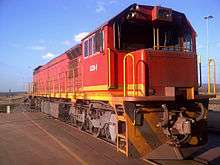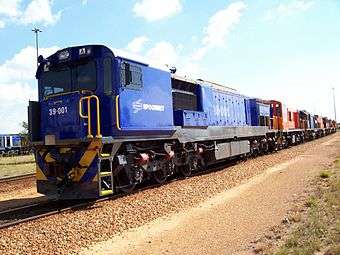South African Class 39-000
The Spoornet Class 39-000 of 2006 is a South African diesel-electric locomotive from the Spoornet era.
| South African Class 39-000 | |||||||||||||||||||||||||||||||||||||||||||||
|---|---|---|---|---|---|---|---|---|---|---|---|---|---|---|---|---|---|---|---|---|---|---|---|---|---|---|---|---|---|---|---|---|---|---|---|---|---|---|---|---|---|---|---|---|---|
No. 39-002 at Pyramid South Depot on 7 May 2013 | |||||||||||||||||||||||||||||||||||||||||||||
| |||||||||||||||||||||||||||||||||||||||||||||
| |||||||||||||||||||||||||||||||||||||||||||||
| |||||||||||||||||||||||||||||||||||||||||||||
| |||||||||||||||||||||||||||||||||||||||||||||
In 2005, Transwerk commenced a project of rebuilding one hundred existing locomotives to new Class 39-000 Electro-Motive Diesel type GT26CU-3 locomotives for Spoornet. Only five were eventually rebuilt and placed in service between April 2006 and 2009.[1][2]
Manufacturer
In 2005, a project commenced to rebuild one hundred Class 39-000 Electro-Motive Diesel (EMD) type GT26CU-3 diesel-electric locomotives for Spoornet from Classes 34-600 and 34-800 type GT26MC and Class 37-000 type GT26M2C locomotives. The original locomotives had all originally been designed by General Motors Electro-Motive Division (GM-EMD) and had been built by General Motors South Africa (GMSA) in Port Elizabeth between 1974 and 1981. Suitable frames from wrecked locomotives were to be used.[1][2][3]
Rebuilding
Number 39-251
Two companies were invited to produce prototypes for the project. One was Electro-Motive Sibanye, a joint venture between the recently established Electro-Motive Diesel (EMD) and Sibanye Trade and Services, a South African Black Economic Empowerment (BEE) company which dealt in locomotives and spare parts. The Sibanye venture produced only one locomotive, which was rebuilt from Class 37-000 no. 37-010 in 2008 and numbered 39-251. The locomotive was tested, but rejected by Transnet, reportedly due to poor quality. Furthermore, when serious tender irregularities came to light, the locomotive rebuilding deal between Transnet and Sibanye was cancelled.[1][2][4][5]

Even though it was painted in the red Transnet Freight Rail livery, no. 39-251 never worked for Transnet.[1]
The locomotive did have the distinctive cab roof profile of other locomotives in the EMD family, unlike the completely different rounded cab roof profile of its successful competitor. When the Electro-Motive Sibanye joint venture was dissolved, the locomotive remained in the possession of Sibanye Trade and Services and was renumbered STS 001. It was later hired or leased to the Khumani iron ore mine in the Northern Cape, where it was renumbered again to LC9-1.
Numbers 39-001 to 39-005
The other company was Transwerk, later Transnet Rail Engineering (TRE) and then Transnet Engineering, who produced five locomotives at its Bloemfontein shops between 2005 and 2008, rebuilt from three wrecked Class 34-600 and two Class 34-800 locomotives. These five were tested and approved by Transnet and placed in service between April 2006 and 2009 as the Class 39-000, numbered in the range from 39-001 to 39-005.[1][2]
It was intended to produce one hundred Class 39-000 locomotives, but in spite of the technical success of the TRE part of the project rebuilding was halted after completing five locomotives, allegedly due to higher than anticipated cost. Instead of rebuilding one hundred old locomotives, it was decided to rather continue the program by building fifty new Class 39-200 locomotives from imported and locally produced components. This was to take place at the Koedoespoort shops of TRE.[6]
Features
The original Class identity of each Class 39-000 locomotive can be visually determined by the difference between their left side sills. The three ex Class 34-600 locomotives have thicker fishbelly-shaped left sills, compared to the thinner straight left sills of the two ex Class 34-800 locomotives.[2][7][8]
Improvements over the pre-rebuilt locomotives which were realised in the Class 39-000 include microprocessor control, 26% more maximum continuous tractive effort and 15% more tractive horse-power, and a Knorr-Bremse electronic brake rack (EBR) to replace the old pneumatic braking controls.[9]
Works numbers
The original Classes 34-600, 34-800 and 37-000 numbers and works numbers of the Class 39-000 locomotives are listed in the table.[1]
| Class 34 or 37-000 No. |
Works No. |
Class 39-000 No. |
|---|---|---|
| 34-635 | GMSA 101-35 | 39-001 |
| 34-838 | GMSA 112-38 | 39-002 |
| 34-674 | GMSA 101-74 | 39-003 |
| 34-620 | GMSA 101-20 | 39-004 |
| 34-829 | GMSA 112-29 | 39-005 |
| 37-010 | GMSA 116-10 | 39-251 |
Service
The five Class 39-000 locomotives were initially placed in service on the Pretoria-Komatipoort section of the line to Maputo in Mozambique to work in conjunction with Class 37-000 locomotives on the heavy grades of the Belfast-Steelpoort section in Mpumalanga. By 2013, once the Class 39-200 locomotive fleet had also entered service, they were redeployed to the Thabazimbi iron ore line and shedded at Pyramid South.[9][10]
Illustration
The main picture shows no. 39-002 at Pyramid South, north of Pretoria, as delivered in Transnet Freight Rail livery. Of the five Class 39-000 locomotives, only no. 39-001 was delivered in Spoornet’s blue livery with outline numbers.
 No. 39-001 in Spoornet blue livery with outline numbers, Koedoespoort, Pretoria, Gauteng, 24 April 2007
No. 39-001 in Spoornet blue livery with outline numbers, Koedoespoort, Pretoria, Gauteng, 24 April 2007- Early construction phase of no. 39-002 photographed from the cab end at Transwerk, Bloemfontein, 7 April 2006
References
| Wikimedia Commons has media related to South African Class 39-000. |
- Middleton, John N. (2002). Railways of Southern Africa Locomotive Guide - 2002 (as amended by Combined Amendment List 4, January 2009) (2nd, Dec 2002 ed.). Herts, England: Beyer-Garratt Publications.
- Information supplied by staff at Transnet Rail Engineering, Bloemfontein and Koedoespoort
- South African Railways Index and Diagrams Electric and Diesel Locomotives, 610mm and 1065mm Gauges, Ref LXD 14/1/100/20, 28 January 1975, as amended
- Railways Africa, 2 Apr 2009: Why Transnet Discontinued That Diesel Order
- Railways Africa, 12 Mar 2009: Transnet Tender to High Court
- Railways Africa, 12 Dec 2008: The Class 39 Diesels
- Class 34-600 sill
- Class 34-800 sill
- Railways Africa, 21 Feb 2006: Spoornet's Class 39
- Railways Africa, 27 Nov 2008: TFR Locos